Market Recap - Saturday, April 16
Chart 1. Overbought and ripe for a fall
After declining by 13.05% on 3/29/22, the market went into rally mode. For a time it looked as if the dip-buyers had regained confidence and were gunning for a new high. They came within 3.44% before running out of steam.
On 3/31/22 I showed the chart below and said that the market looked overbought and ripe for a fall. Now that we've had that overbought pullback, where do we go next? I'll address that in my final thoughts at the end of this article.
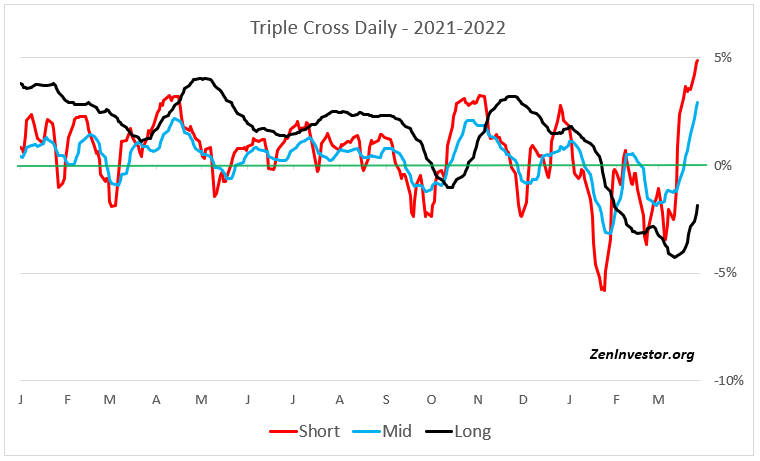
Chart 2. No longer overbought
Fast forward to today and you can see that we are no longer overbought, at least on a short-term basis. Over the last 12 trading days we have given back 239 points on the S&P 500 and the drawdown stands at -8.42%.

Chart 3. Major Markets
I divide the global equity market into 7 segments - U.S. Total Market, U.S. Small Cap, Nasdaq, Foreign Developed, Europe Developed, Asia Large Cap. and Emerging Markets. As with all the charts, I show the year-to-date return. You can follow the money as it moves among these seven market segments.
Emerging Markets have taken the smallest hit so far this year. Most of the global markets are down YTD except for some South American commodity-exporting countries (see the last chart for details). The most damage is concentrated in the Asia 50 mega-caps (like Samsung, Tencent, and Alibaba) and the Nasdaq, which is dominated by mega-cap tech names like Microsoft, Google, Meta (Facebook), and Nvidia.
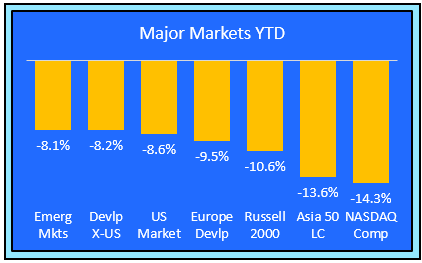
Chart 4. Market Sectors
Of the eleven primary market sectors, this chart shows the top three and bottom three performers. I do it this way to keep things simple.
Money has been flowing out of tech, consumer discretionary, and communications services, and into energy, utilities, and materials. This trend will probably continue as long as there is uncertainty caused by the Russia-Ukraine war. Demand for oil & gas remains high, the global economy is taking a hit to growth. and inflation will continue to rise until energy prices begin to break down.
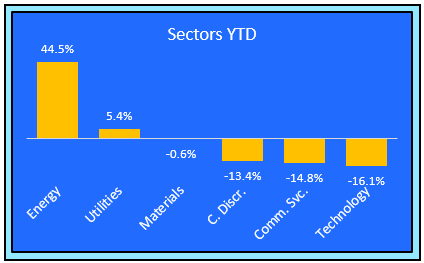
Chart 5. Industries
Of the 60 industry groups tracked by S&P Global Markets, I highlight the top and bottom four to keep this chart simple. The chart speaks for itself.

Chart 6. Styles - Growth vs. Value
After slightly underperforming growth last year, value is where the money is flowing. I see this as another durable trend. Growth has been hit hard by the slide in tech stocks this year.
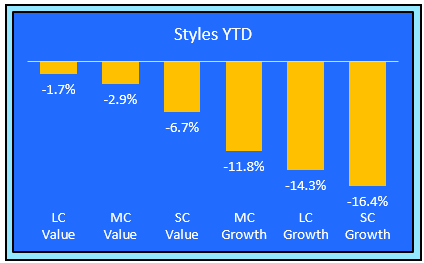
Chart 7. Size
Small caps are still lagging. After underperforming last year, they are struggling to keep up this year. Mid caps were almost tied with large caps last year, and the are in the lead this year. The flow of money into mid caps looks like a durable trend.

Chart 8. Factors
There are more than 100 factors to choose from, so I had to cut the list to just six, in order to keep this chart reasonably easy to digest. Momentum names are getting pummeled this year after a solid showing 2021.
The top performing factor so far is dividend yield. I'm not sure about the durability of this trend, because rising bond interest rates will begin to compete with dividends at some point.

Chart 9. Sensitivity to the business cycle
In this chart I divided the market sectors into two groups - those that respond more vigorously to the changing phases of the business cycle (cyclical), and those that respond less vigorously (defensive).
With the economy still in growth mode, cyclical stocks should do better than defensive stocks. That hasn't happened yet this year, and maybe the market is sending a signal that the economy isn't as strong as many would like to believe.
The flow of money away from cyclicals and into defensive looks durable.
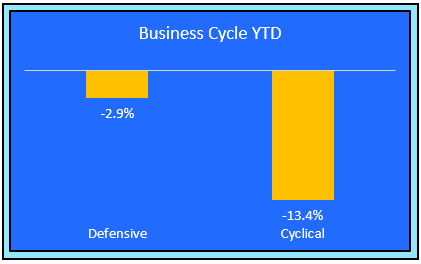
Chart 10. Bonds
It's interesting to watch how the various flavors of bonds react to Quantitative Tightening. So far it looks like Treasury bonds are seeing the most outflows. That's understandable, given the sharp rise in the 2-yr and 10-yr rates.
Keep an eye on junk bonds, because they are especially vulnerable to an economic slowdown. If they continue to lose momentum, the risk of recession increases.

Chart 11. Countries
There are 50 countries that are represented by ETFs. Here are the top and bottom performers YTD. South America is having a resurgence this year, while Europe is struggling with geopolitical issues and heavy sanctions - both imposed and threatened. I removed Russia from this chart because their stock market is essentially closed to outsiders.

Final thoughts
We are now well into 2022 and the trends we have established thus far will probably continue as long as the war, and all the uncertainty it brings with it, remains in place. By keeping an eye on money flows among these asset categories, you can gain some insight into what could be a durable trend, and what's just noise.
The trends that look the most durable to me at this time are value vs. growth, mid cap vs. large and small cap, defensive vs. cyclical, and commodities - especially energy - vs. tech.
European and Asian economies seem more vulnerable to the fallout from sanctions against Russia. There is a chance that Europe may slip into a recession later this year, and some Asian countries may follow after that.
The US will likely avoid a recession this year, but the picture may change in 2023. The major Wall Street strategists have been reducing their price targets for year-end, with an average of 4900 for the S&P 500. That would represent a gain of 11.6% from where we are now, and a year-over-year gain of just 2.8%.
As the late Marty Zweig used to say, don't fight the tape and don't fight the Fed. The tape is weak and the Fed appears to be gearing up to bring inflation under control. If the market ends the year with a small gain, it behooves investors to pick their spots carefully. That's why I like to follow the money.
Disclaimer: This content is for educational purposes only, and ZenInvestor.org is not an investment advisory service, nor an investment advisor, nor does ZenInvestor.org provide personalized ...
more


